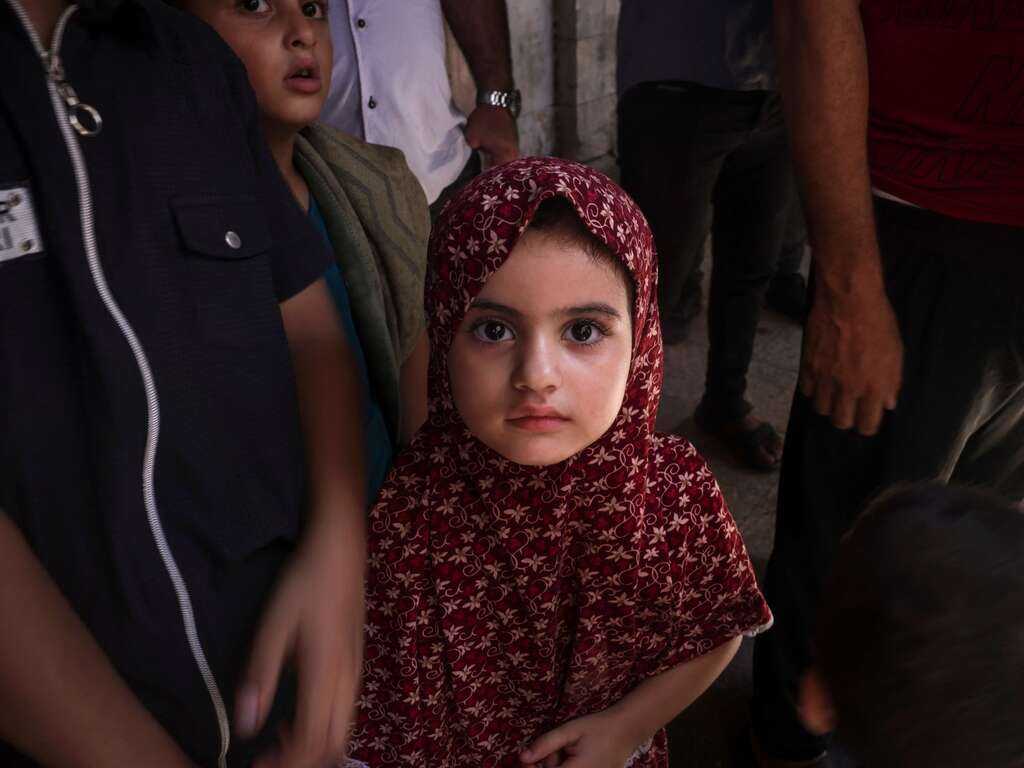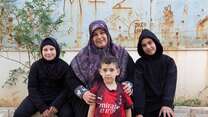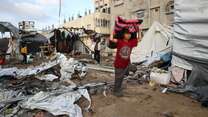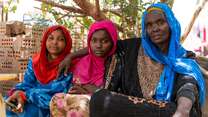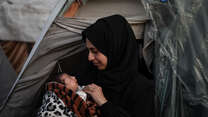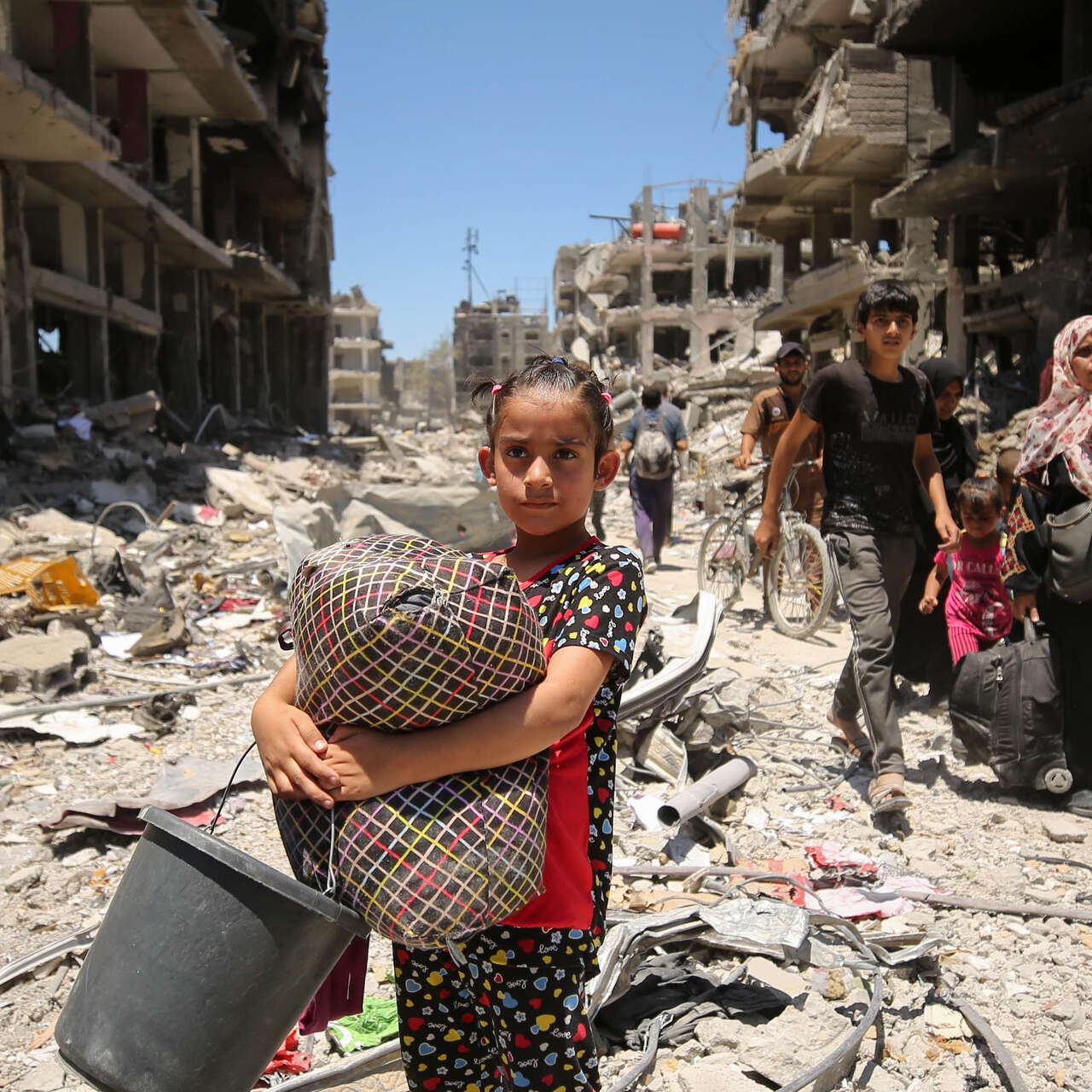
After more than a year of raging war, conflict in the Middle East widened across Gaza, the West Bank, and Lebanon. The loss of civilian life is horrific. International Rescue Committee (IRC) teams, and our partners, are working across the region to sustain life and livelihood in conditions that are desperate and dangerous. This article focuses on the mounting humanitarian crises, and what we are doing to help meet them.
Widespread destruction in Gaza
On October 7, 2023, the decades-long conflict in the region experienced an unprecedented escalation when Hamas and other Palestinian armed groups launched a deadly attack on Israel. The attack killed 1,200 people. Over 200 hostages were seized and over 100 are still unaccounted for.
Israel then launched a devastating wave of airstrikes and ground operations inside Gaza that have killed more than 46,000 people. The widespread destruction of civilian infrastructure has had a rapid and catastrophic impact on Gaza and its two million residents. About ninety percent of Gaza’s population has been displaced, most multiple times, and the entire population needs humanitarian assistance. Persistent Israeli restrictions on the flow of humanitarian aid and movement of humanitarian staff, including at borders, crossings and within Gaza, has made it extremely difficult for humanitarian organizations to respond to the needs of the population. In fact, figures show that less aid went into Gaza in the last three months of 2024 than at any time throughout the year. More than 350 aid workers have been killed, over 250 of whom worked for the United Nations, with the vast majority being Palestinian. Forced displacement orders continue to undermine the humanitarian response by requiring people to flee to already overcrowded and often unsafe areas, overwhelming already strained resources like food, water, and medical care.
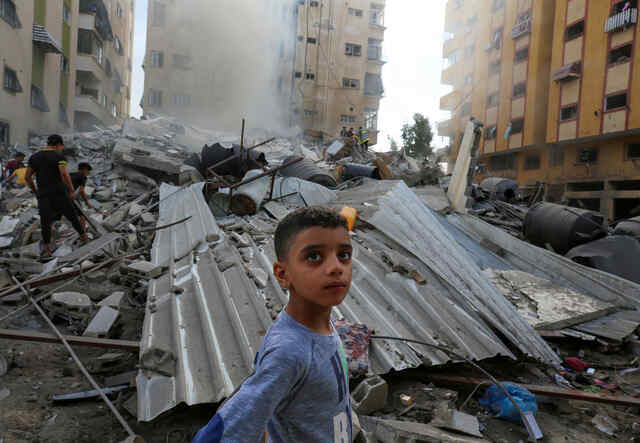
All of Gaza now faces dangerously low supplies, as critical services like water, power, and fuel supplies have been cut off or disrupted. The spread of infectious diseases including Polio, Hepatitis A and diarrhea has skyrocketed, due to the lack of available drinking water, clean water for safe hygiene practices and overcrowded conditions in temporary shelters. Gaza is also facing an unprecedented food crisis with more than 90% of the population (some 1.9 million people) facing crisis or worse levels of acute food insecurity. Northern Gaza is now beyond crisis point. The Famine Review Committee (FRC) is warning that famine is likely imminent, if not already underway, in parts of northern Gaza. IRC teams in Gaza are seeing increased rates of severe and acute malnutrition in children under five.
Gaza is one of the most densely populated places in the world
Israel and Hamas are obligated to take all measures to minimize harm to civilians. However, the use of explosive weapons (missiles and bombs) in densely populated areas, and the launching of attacks from these areas, has led to massive civilian harm.
According to the United Nations Office for Humanitarian Affairs, which bases its figures on the Gazan Ministry of Health statistics, the ongoing conflict has killed over 46,000 Palestinians across Gaza. Over 100,000 people have been injured, and around a quarter will require lifelong care, following amputations and spinal injuries. Countless more people are missing or trapped under the rubble, believed dead.
Attacks on and fighting around hospitals have left much of Gaza’s population without access to medical care and the huge number of casualties has left health facilities and workers overwhelmed.
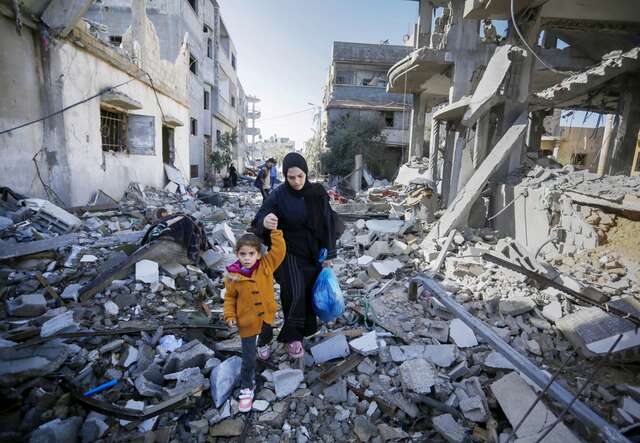
Gaza is not getting the aid it needs
The scale of suffering and destruction in Gaza demands a massive and sustained humanitarian assistance effort. However, the delivery of aid and services has not matched anything like the massive needs on the ground. Persistent restrictions on the flow of humanitarian aid into and around Gaza, including Israeli restrictions on entrance of aid and critical commercial supplies, repeated displacement orders that upend humanitarians’ ability to operate, and attacks on humanitarian workers are driving a desperate shortage of food, fuel, medicine, equipment and humanitarian staff in Gaza.
Civilians, including women and children in northern Gaza are largely cut off from aid and health care, with no functioning hospitals remaining. Israeli military operations in Rafah, which began in May 2024, have significantly obstructed aid operations across the whole of Gaza. Rafah—a critical border crossing—had been the epicenter of the humanitarian response and there are not enough alternative aid crossings open.
The lack of commercial and humanitarian supplies is compounding the desperation—contributing to a breakdown of order and raising the risks of looting. The IRC and the wider humanitarian community have used our experience in conflict settings around the world to make sure that aid is delivered to those who most need it.
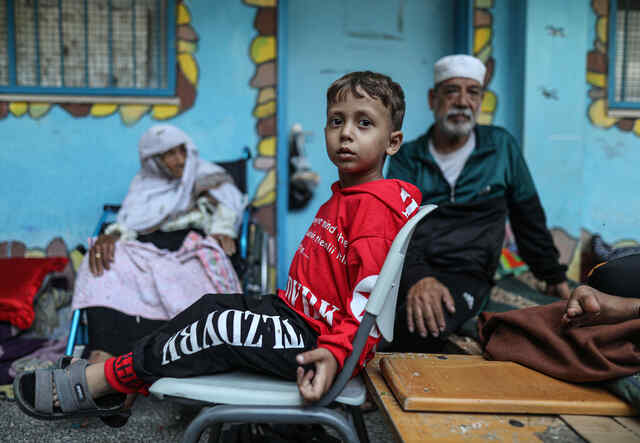
Mounting violence in the West Bank
Since 7 October 2023, more than 900 Palestinians have been killed, a quarter of them children, an over 100 percent increase compared to 2022. At the same time, 49 Israelis have been killed in the West Bank. The humanitarian situation has deteriorated rapidly in recent months, as Palestinians face the highest levels of violence since UN OCHA records began in 2005. Israeli military incursions, destruction of Palestinian property, rising settler violence and severe movement and access restrictions have deepened the crisis, undermined capacity of health facilities and caused rising forced displacement. This intensified fighting has included unprecedented and disproportionate use of airstrikes and heavy weaponry.
Acute humanitarian need in Lebanon
On November 27, 2024, Israel and Hezbollah agreed to a ceasefire, bringing with it a level of relative calm after two months of intense ground combat and airstrikes and over a year of cross-border fire.
Ground conflict and Israeli airstrikes in late 2024 killed more than 3,800 people and forced over 1.4 million —a mix of mostly Lebanese and Syrian nationals—to flee their homes.
Most, over 870,000 people, remained within Lebanon, while another 510,000 were displaced to Syria. Many stayed with relatives, in overcrowded shelters with poor sanitation and limited health care, on the streets, or in unfinished buildings. Syrian refugees often faced restrictions on access to collective shelters.
The ceasefire is still fragile and does not end the acute humanitarian need in country on its own. People are now returning to their homes on both sides of the border, but with nearly 25% of buildings in southern Lebanon destroyed and many more damaged, the effects will be long-lasting.
Families across Lebanon continue to contend with the impact of conflict on top of a multiyear economic crisis that has weakened the health care system and left record numbers of people going hungry.

What needs to happen?
The IRC welcomes the ceasefire in Lebanon and urges its full implementation. Even before this crisis, the humanitarian situation in Lebanon had already stretched resources beyond their limits. Immediate and flexible emergency funding is urgently required to scale up humanitarian assistance, ensuring those affected by the conflict receive the help they desperately need.
In Gaza:
An immediate ceasefire
The IRC is calling for an immediate ceasefire as envisaged by the UN Security Council Resolution 2735. From a humanitarian perspective, the resolution makes clear that a ceasefire will deliver the following for civilians: “an immediate, full, and complete ceasefire with the release of hostages, the return of the remains of some hostages who have been killed, the exchange of Palestinian prisoners, withdrawal of Israeli forces from the populated areas in Gaza, the return of Palestinian civilians to their homes and neighborhoods in all areas of Gaza, including in the north, as well as the safe and effective distribution of humanitarian assistance at scale throughout the Gaza Strip to all Palestinian civilians who need it.
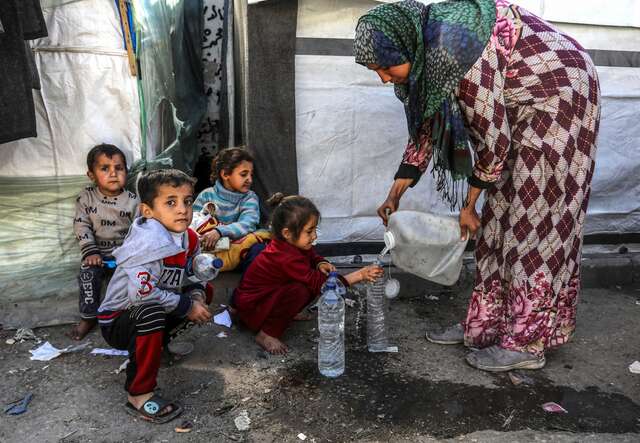
A humanitarian reset
The only way to fully address the aid delivery challenges in Gaza is a ceasefire paired with a comprehensive “humanitarian reset.” This demands a clear, immediate and accountable plan to:
- Open all viable border crossings to goods and personnel
- Streamline inspection processes and expand the list of permitted supplies
- Ensure protection/safe movements for humanitarian and medical workers
- Restart water, electricity and fuel supplies
- Establish benchmarks that measure impact rather than count trucks
Fidelity to international law
All parties are required by international law to take steps to protect civilians and uphold international law, which demands protecting civilians and the infrastructure they depend on to survive. Hospitals, electricity and water plants and centers for internally displaced people must not be targeted. International law requires Israel to ensure all military operations apply the fundamental principles of distinction, proportionality, and precaution. Under international law, Israel is defined as the ‘occupying power’ and has obligations to ensure that the civilians receive adequate food, water and shelter and can access suitable sanitation and health care facilities. International law also says that Hamas and other Palestinian groups must release hostages, refrain from deliberate or indiscriminate rocket attacks against civilian areas inside Israel, and from launching military attacks from within, or close to, civilian infrastructure in Gaza.
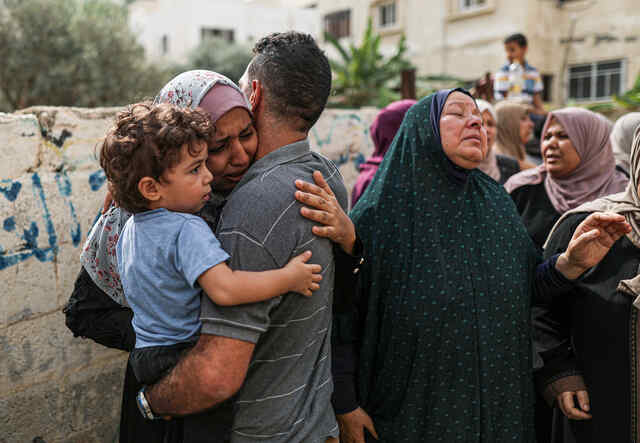
In the West Bank:
The IRC urges Israel to halt the use of airstrikes and use of other military-grade weapons in the West Bank. The deployment of these tactics and weapons is driving higher civilian casualties and destruction of civilian infrastructure. Israel must also uphold its obligations to ensure and active protection of civilians and health care services in the West Bank.

How is the IRC responding?
Gaza
Despite numerous challenges and obstacles, the International Rescue Committee (IRC) and partners in Gaza are delivering emergency and life-saving medical care through mobile health points for those displaced. Our teams and partners are working tirelessly to treat malnutrition in children, provide mental health and psycho-social support sessions to those suffering from acute trauma, and provide specialized protection services, including case management and support for unaccompanied and separated children. We are also providing critical medical supplies and pharmaceuticals, food parcels and delivering clean water.
The IRC’s response in Gaza draws on our global experience and expertise in emergency response, as well as our longstanding presence in the region. Palestinian partners have been leading the response in Gaza and we are supporting their objectives through financial, technical and operational support.
Emergency Medical Teams
Prior to October 2023, there were 36 hospitals in Gaza. There are now no fully functioning hospitals, with only 19 partially functional. There are currently no hospitals functioning in northern Gaza. Those few remaining facilities are completely overwhelmed and lack health care personnel and basic supplies. Patients are dying from infections as hospitals are at breaking point due to the skyrocketing demand for medical services.
“These health care facilities are not built for mass casualty. And in fact, no hospital in the world is built for this kind of sustained severity of mass casualty, nor could any be able to sustain it,” says Dr. Seema Jilani, Pediatrician and member of IRC and our partner’s first Emergency Medical Team, who deployed to Al Aqsa Hospital in Middle Gaza as a member of the IRC’s emergency medical team.
Much of Gaza’s water and sanitation facilities have been partially or fully destroyed, leaving 1 million people at risk from sanitation related threats, including rodents and pests, solid waste, sewage and human waste.
The IRC and our partner deployed twelve successive Emergency Medical Teams to provide emergency and life-saving medical care, including direct medical care at hospitals, and the distribution of medical supplies and pharmaceuticals. The team, composed of trauma doctors, surgeons, pediatricians and disaster experts, offered surge and relief support to hospitals and provided life-saving medical care to injured Palestinians.
Medical supplies and pharmaceuticals
The IRC procured and delivered 46 metric tons of pharmaceuticals and medical supplies which the IRC and our partners are distributing to support health facilities across Gaza. These include pediatric and psychotropic medicines as well as trauma supplies and are based on needs identified and coordinated across health actors working in Gaza.
We have partnered with Palestinian NGO, Juzoor for Health and Social Development, to address the health and mental health needs of those displaced and to provide access to basic services for children and families. Together, our 15 mobile health teams have provided more than 36,500 patient consultations in northern Gaza. The teams were providing health services in 15 highly populated shelters in northern Gaza since February.
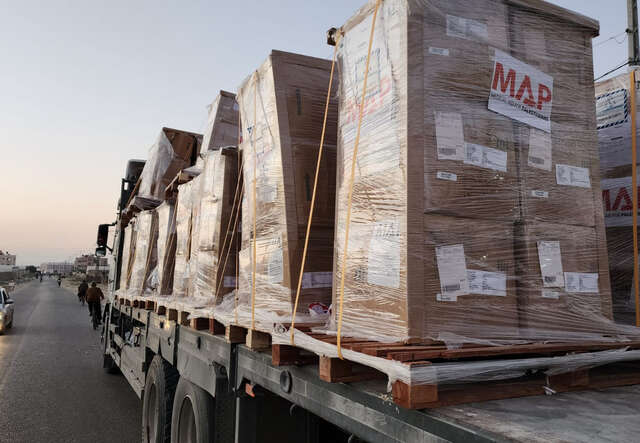
Mental health support for children
Even before the increase in hostilities, at least half a million children in Gaza needed mental health and psychosocial support. Now, every child, parent and caregiver in Gaza has experienced profoundly distressing events and trauma, characterized by extensive destruction and displacement.
In partnership with Nafs we are delivering mental health and psychosocial service (MHPSS) activities through six mobile community centers—three in Gaza and three in the West Bank. Our partnership with Nafs is expected to deliver support to 5,000 children within the next few months.
IRC has also partnered with Center for Women’s Legal Research, Counseling and Protection (CWLRCP) to provide sheltering services for women and girls impacted by gender-based violence. The partnership will also provide mental health and psycho-social support sessions for women, as well as livelihoods support.
Finally, in light of escalating violence in both Gaza and the West Bank, IRC has partnered with Teacher Creativity Centre (TCC) to address the cognitive, socio-emotional and physical well-being of children impacted by acute stress in Deir al-Balah in Gaza and Jenin in the West Bank. Our partnership will train teachers, therapists and caregivers in socio-emotional teaching techniques as well as providing educational programs to support cognitive and emotional development for children impacted by violence.
Helped families with basic needs
Farmers in Gaza are now unable to produce food. An estimated 70% of cropland has been destroyed in some areas while 70% of livestock providing meat or dairy products have been killed.
Severe shortages of food and clean water mean that the entirety of Gaza’s population is facing crisis levels of food insecurity.
Although lack of humanitarian access is likely obscuring the full picture of hunger in Gaza, the UN has reported that children are already dying of hunger.
The International Rescue Committee (IRC) and Welfare Association (Taawon) partnered to combat the severe hunger affecting displaced families in Rafah, southern Gaza, where over one million people have been displaced and have sought refuge in what is considered Gaza’s last haven. Together, we delivered fresh food parcels to approximately 3,500 families between January and February 2024.
IRC has partnered with Agriculture Development Association (PARC) to address the urgent needs of displaced Palestinians in Gaza amid imminent famine and health crises. Together, the partnership is combating acute malnutrition, which has already claimed the lives of over 30 people, including 28 children, while also responding to the collapse of water and sanitation systems. Their efforts include distributing 1,700 fresh vegetable baskets to support dietary needs of the displaced population and the local economy, providing cash assistance to more than 400 families, and enhancing WASH facilities in ten critical shelters through repairs, minor rehabilitations, and hygiene activities.
IRC has also partnered with Palestinian Hydrology Group for Water and Environmental Resources Development (PHG) to improve Palestinians’ access to clean, safe drinking water, through rehabilitation of existing and damaged water sources and water trucking. The partnership will also ensure awareness of safe hygiene practices.
Our impact
With partners we have supported the health, education, safety and economic wellbeing of more than 180,000 people in Gaza, this includes:
- Providing more than 36,500 patient consultations by mobile health teams with our partner Juzoor
- Procuring and delivering 46 metric tons of pharmaceuticals and medical supplies
- Deploying twelve successive emergency medical teams
- Provided psychosocial support services for 9,000 children through our partnership with Anera
- Supporting more than 3,500 households with food delivery in partnership with Tawoon and the Agriculture Development Association (PARC)
- Delivering 30,000 liters of drinking water each day, serving 17,000 persons per day with an average of 3L per person
West Bank
IRC and its partners launched a program to enhance emergency preparedness for health services in the West Bank, focusing on Tulkarm and Hebron, some of the areas worst hit by violence in the last year. We are working to prepare hospitals and communities by surging necessary supplies and training staff personnel to handle increased demand for life-saving services during emergencies via new trauma care protocols as well as first aid training for community volunteers. Our ultimate goal is to work with our Palestinian partners to strengthen the health system's capacity and maintain critical health services during crises, saving as many lives as possible.
IRC is also working through partners to deliver child protection, women’s protection and empowerment and education.
IRC has partnered with Psychosocial Counseling Center for Women (PSCCW) to address the severe challenges facing Palestinian women and children in the West Bank. The partnership focuses on empowering these communities through comprehensive mental health and psychosocial support, supporting 250 women GBV survivors and 470 children to develop resilience against trauma. Additionally, this includes economic empowerment through cash-for-work programs for 40 female graduates, aiming to strengthen economic independence and enhance community well-being.
Lebanon
The IRC has been providing life-changing support to both Lebanese citizens and refugees since 2012. In response to the September 2024 escalation of conflict, the IRC swiftly launched a comprehensive emergency response. Working alongside local partners, we have been supporting people displaced by conflict with hot meals, cash assistance, shelter materials, hygiene kits, and lifesaving protection, health and mental health services, reaching tens of thousands of affected people.
We started our Emergency Response at the IRC at the beginning of escalations, delivering urgent assistance to internally displaced people across the country.
With our local partners, we provided over 50,000 hot meals, cash to more than 700 displaced families, distributed core relief items to more than 2,700 people and offered more than 5,000 different health services through our work with primary health care centers.
As a leading organization in the Protection sector, the IRC place a priority on support for unaccompanied and separated children to reunite them with their relatives and provide assistance to survivors of gender-based violence.
What will remain unchanged in the IRC's response is our commitment to addressing the urgent needs of vulnerable communities. We have supported thousands of internally displaced people, and now it's time to also reach those who have returned to their areas and homes. The priority will continue to be our support to access health, education, cash and core relief items, as well as protection services for children, women, and all vulnerable communities, including Lebanese and Syrians.

How can I help?
The IRC is working with partners to deliver critical emergency aid to families across the middle east and conflict zones around the world. Donate now to support our critical work. We are on the frontlines providing critical aid to crisis-affected people in more than 40 countries, including places on the 2025 Emergency Watchlist.
Read more about the top 10 crises the world can’t ignore in 2025 and learn more about the IRC's 2025 Emergency Watchlist.
